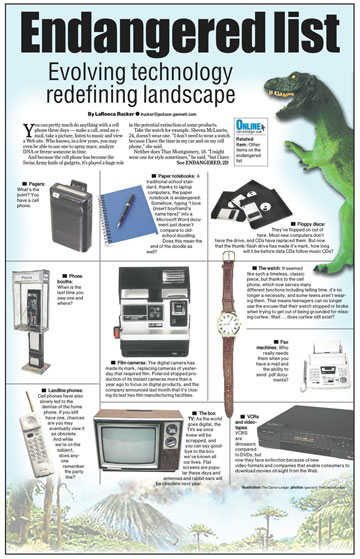Endangered list
Evolving technology redefining landscape
By LaReeca Rucker

You can pretty much do anything with a cell phone these days - make a call, send an e-mail, take a picture, listen to music and view a Web site. Who knows, in a few years, you may even be able to use one to spray mace, analyze DNA or freeze someone in time.
And because the cell phone has become the Swiss Army knife of gadgets, it's played a huge role in the potential extinction of some products.
Take the watch for example. Sheena McLaurin, 24, doesn't wear one.
"I don't need to wear a watch because I have the time in my car and on my cell phone," she said.
Neither does Thay Montgomery, 18. "I might wear one for style sometimes," he said, "but I have the time on my phone."And Shuntwon Simmons, 16, is also watchless. "Only one of my friends wears one," he said.
It's become a defining characteristic of the new generation, sometimes called the millennials or iGens. But the watch is not the only element of modern society that may be going the way of the dinosaur thanks to technology and changing attitudes.
There are many things that could wind up in a nostalgic realm with acid-washed jeans, canned food, candy cigarettes, California Raisins, Baby on Board stickers, the answering machine, the typewriter and the decorative ashtray.
Watch out
According to USA Today, watch sales among 18- to 24-year-old Americans reached nearly $1 billion in 2000, but by 2005, sales had dropped 34 percent. Sales also dropped 28 percent over five years among 35- to 49-year-olds.
Contrary to statistics, employees say watch sales have been strong at Albriton's Jewelry in Jackson. But Crawford Fuller, watch service manager, agrees that watches are used less today for telling time and more as a fashion accessory. He said fine watches can range from $3,000 to $50,000 and up and predicts they won't become extinct.
"Maybe the younger kids are using their cell phones because they're not in the mainstream business world yet," he said. "There's still a very high demand for high-end watches. The cell phone won't be its demise because a nice watch is still something of a mark of accomplishment."
John Lyons, of Vintage Time Works in Ridgeland, said fewer watchmakers exist today than in the 1960s, but watches are still selling well, with the average person spending $200 to $4,000 on one. However, they are typically being purchased by adults.
"I don't get many kids in here at all with watches," he said. "You wouldn't believe how many people come in, pull out their cell phone and say 'Hey, I have my watch right here with me.' "
Landline phones, the box TV, the VCR, CDs, fax machines, floppy discs and pagers are also endangered.
Tony Ammeter, an assistant professor of management information systems at the University of Mississippi's School of Business, teaches a class about the strategic management of innovation.
Each week, students examine two competing technological products, like the high-definition DVD vs. Blu-Ray, and debate which will become extinct. The business terminology for survival of the fittest is "leap-frogging."
Ammeter said the key to leap-frogging the competition is having a superior idea and being able to develop it so you attract a core group of users early on.
"They have to be people that other people look to as trend-setters," he said. "There's always a core group of geeky people who try something out, but they're not really as respected as the mass audience.
"And the product must meet a specific need. They're not just buying it because it's a gadget; they're using it because it actually solves a problem."
Ammeter said one of the paradoxes is that the company with the dominant technology is often more likely to face extinction by a start-up because research has shown the dominant company is least likely to succeed in building something better than it already has. In order to succeed, it must do something different, and therein lies the problem.
Ammeter said companies become extinct because they are generally either complacent, falsely believing their product is superior, or they have a hard time figuring out what their competitor is doing.
"And sometimes, they don't take time to look at the competitor's product," he said. "Basically, either you go outside the company or try to train your people to think outside the box, and that's not easy."
Alan Marcus, who heads the Mississippi State University history department, is author of Technology in America: A Brief History. He said new technology not only leads to product extinction, it also changes the way we view the world.
"When I was a kid, you had a watch, and the face of the watch had hands," he said. "Every day, you wound it, and you could watch it go around. You could see how the minutes related to each other.
"Then they started making digital watches, and each moment in time was the only one that appeared, so you began to see that each thing is separate and not part of a whole, and it gave you no perspective on how things are tied to the past and future."
While early technological introductions had some unifying characteristics, Marcus said today technology both defines and divides generations.
"When I talk about the advent of the transistor radio in the mid-'50s, it appealed to the individual, rather than the family," he said. "Before then, families listened to the radio collectively. But with the transistor radio, each little teenager could take it off and go be by himself.
"At the same time, everyone was yelling about the younger generation and how Elvis was a shocking, terrible person. The younger generation wanted to be separated from the older generation."